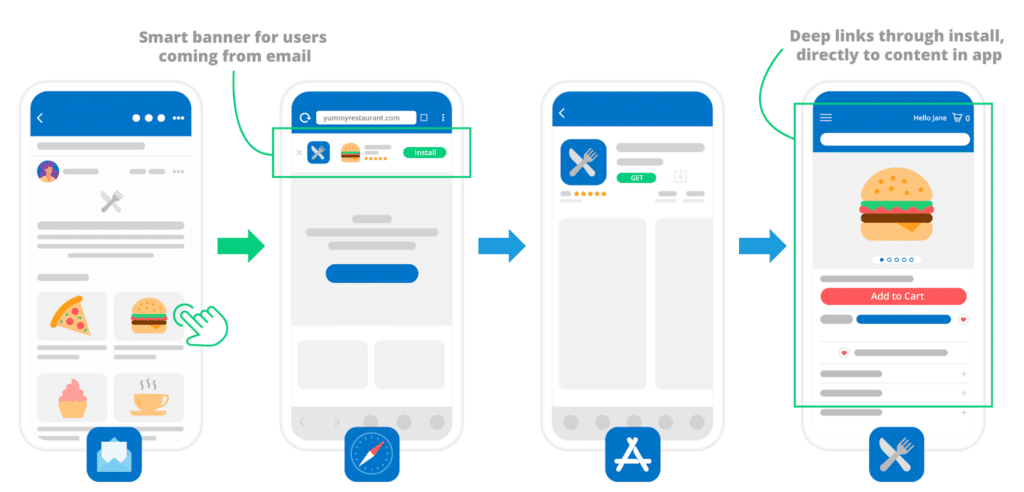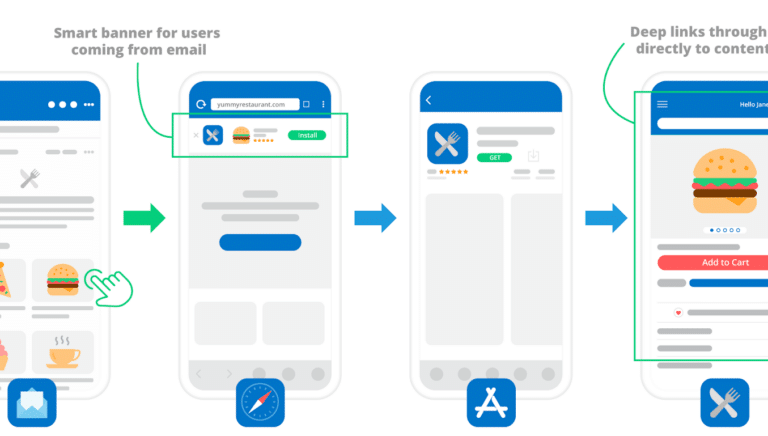Email is one of the best channels you can use to continually engage with users and get them to come back to your app. Many mobile marketers and developers utilize email in an attempt to keep the user beyond the first install, especially when 25% of new apps are abandoned after first use.
However, when it comes time to launch an app engagement or acquisition campaign via email, marketers are left with a bad choice, particularly on iOS: maintain the click reporting they have always had from their Email Service Provider (ESP), or drive a more seamless customer journey into the app for higher performance — and learn a completely new workflow to do so — but be forced to turn off click tracking.
So how is a marketer supposed to solve the seemingly impossible problem of getting users to click on their campaigns and into the app, but having to sacrifice click tracking?
Enter Branch’s world-class mobile email solution: Universal Email.
What makes a good mobile email implementation?
A functional mobile email implementation requires the following:
- The full functionality of an email service provider. A full-service mobile email implementation will not require you to sacrifice any of the functionality or benefits of your email service provider.
- Emails that deep link, and links that can be configured to support web-only or in-app only content. The user experience shouldn’t have to be less than optimal because your content isn’t on both platforms.
- The ability to click track. You shouldn’t have to disable your ESP’s click tracking functionality in order to enable deep linking behavior.
- The ability to support multiple apps with one click tracking domain. It can be hard (and costly) to set up new click tracking domains and a robust ESP integration should not require it.
- Integration into your existing workflow. Your current workflow shouldn’t break or change from adding a mobile email implementation.
- The ability to perform cross-channel and cross-platform measurement. It’s critical to have a full understanding of your email campaigns across channels and platforms to understand your user’s journey and optimize your ROI.
These criteria are what separate a good mobile email implementation from the rest of the pack.
This is difficult to build on your own or get directly through an ESP. Here’s why:
On iOS, the primary deep linking standard today is Universal Links, and Universal Links don’t support redirects; the first URL requested (which is the URL of the initial link the user clicks on) is what matters, and is where users are routed to. If a corresponding app is installed, it will open immediately and any further redirects are ignored. If not, the user is routed to Safari as a fallback and further redirects will resolve as usual. This is a problem, as click tracking is one of the most important metrics for email (because it allows marketers to verify campaign performance and results), and the industry-standard of using wrapped links directly conflicts with Universal Link behavior. The solution is to configure your click tracking domain to support Universal Links, and implement in-app logic to make sure click events continue to be sent in all situations. This is a complex, technical process that most ESPs are not equipped to handle.
Branch Universal Email
Branch invented the concept of “deep linked email” (now named Universal Email) in 2016, where we work directly with ESPs to build integrations that let the ESP continue to handle click tracking, but the deep linking functionality is powered by Branch (a solution that lets each provider focus on their main competence area).
Now we have over 50 fully integrated ESP partnerships including Adobe Campaign, Braze, and Salesforce, and these integrations are deployed at scale by customers all around the globe: over the last 30 days alone, our platform has handled over 100 million clicks from Universal Email partners.
Why does robust deep linking from email matter? Not only does it provide a better user experience, deep linking from email drives revenue and app engagement: with Universal Email, our customer Zaful increased revenue from email by 210%, and increased their email click-to-app open rate from 0% to 28%.
ESP Support for Universal Links
Over the last few years, some of the more sophisticated ESPs have finally built infrastructure to support Universal Links natively. However, these solutions come with lots of limitations:
1. ESPs aren’t in the deep linking business
ESPs don’t have the resources or expertise to track and solve the numerous edge cases that come with deep linking. If Apple or Google change any deep linking standards (which happens all the time), good luck getting a timely update from your ESP — and don’t be surprised when your links break.
Then there’s the problem with matching accuracy. Deep linking, and deferred deep linking in particular, require top-notch SDKs with stellar matching accuracy. This is hard even for mobile-first vendors to get right, let alone an ESP.
2. ESP’s can’t measure in-app activity
ESPs aren’t equipped to measure in-app conversions, app installs/opens, or in-app purchases. Nor can they compare email performance against other marketing campaigns. This is simply not their main job.
Sure, there are tracking methods like UTM tags. However, tools that look at ESP-passed data are built with the web in mind, and thus don’t work when measuring activity across mobile apps. The result is a data black hole — as the number of users and activity on your mobile app rises or falls, this activity won’t be measured with an ESP.
3. Integrations aren’t ‘enterprise-ready’
Most companies just want deep linking to happen automatically. They don’t want to update workflows, or add additional steps to convert links into deep links. For them, the ideal solution is to have no changes to their existing workflow, but that email links simply just start working with apps. ESP deep linking solutions can’t provide this.
The Traditional MMP <> ESP Integration
Legacy attribution vendors have recently started trying to compete with Branch’s Universal Email product.
However, these other vendors haven’t taken the time to build true integrations. For example, in most cases they’re relying entirely on ESP-powered Universal Links wrapped around their own second-tier deep links. This means you’re getting the worst of both worlds: sub-par deep linking support from the ESP, layered on top of sub-par deep linking support from a legacy MMP. The result is painful manual workflows, slow support for technical ecosystem changes, and support limited to only the few ESPs that have managed to build their own in-house Universal Linking.
Branch’s solution deep links your users from your email campaigns, integrates into your existing workflow, and provides edge case handling and full attribution and analytics to compare your email campaigns to your other marketing activities.
Here are two examples of workflows from a legacy MMP vs Branch:
1. Static link in email footer (for example, ‘View Account’)
With a traditional MMP, you’d have to manually create this link via their dashboard and paste into the ESP’s email template
With Branch, simply add your web URL directly into the ESP’s email template. Based on your existing Branch integration, the link is automatically enabled to deep link into the app.
2. Ecommerce marketing email with dynamic product suggestions
With a traditional MMP, you’d have to manually create individual deep links for every single product, every single time, in order to link to the relevant product from email to app.
With Branch, your workflow doesn’t change whatsoever. Build the email as usual and link your specific products, and all links are automatically deep linkified.
Advanced: The Customer Email Journey
The customer journey to conversion is intricate, but we know that getting them into the app is crucial: 66% of transactions on mobile occur in the app, and the app converts 3x more than the mobile web.
Still, if the app is not already installed, many brands don’t want to take users directly from an email to the App Store — they’d prefer these users to land on the mobile web so as not to interrupt a potential conversion.
If this sounds like you, there’s a solution out there. If you prefer to take your users to the mobile web, show a Branch Journeys banner on the page specifically targeted for users coming from a certain email (our built-in custom audience creator in the dashboard makes this insanely easy). After the user clicks the Journey, preserve the context of the user’s click through install so they see the relevant content they were viewing on email and the mobile web.

An example of taking users coming from a specific email to the mobile web, where they’re shown a custom Journeys banner that prompts them to download the app. The context of the user’s click is preserved through install.
Conclusion
Despite what you may hear, it isn’t easy to build a quality email deep linking integration, which is why legacy vendors just haven’t been able to do it. Luckily, Branch’s Universal Email is a far cry from those second-tier solutions. With automated deep linking that works everywhere, edge case handling, cross-platform insights to help optimize your ROI, and integrations into your existing workflow, improving the performance of your email campaigns has never been easier.






















